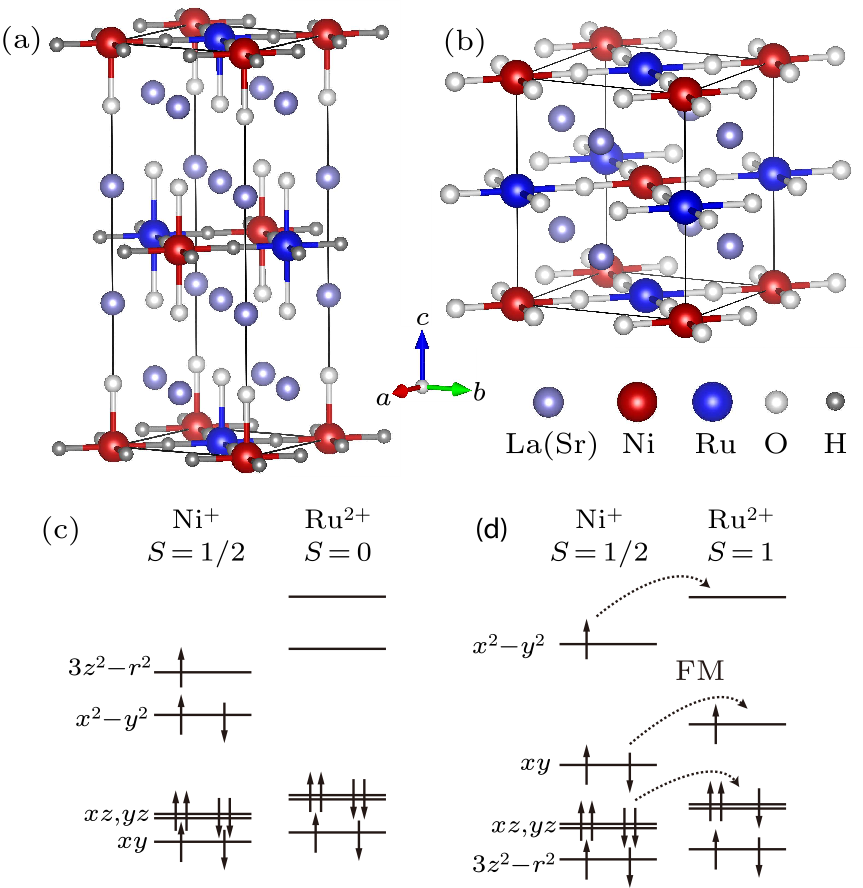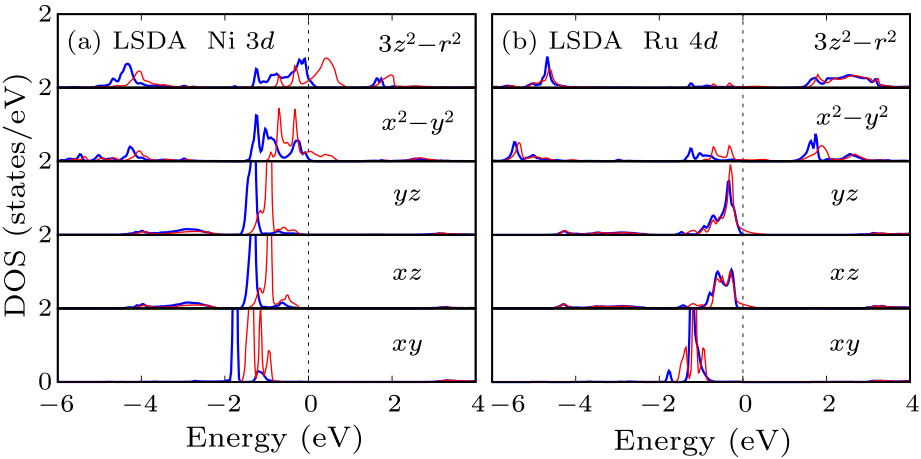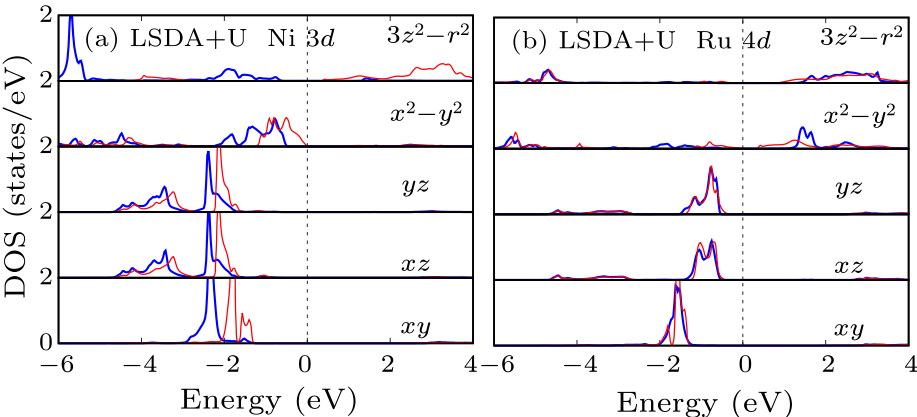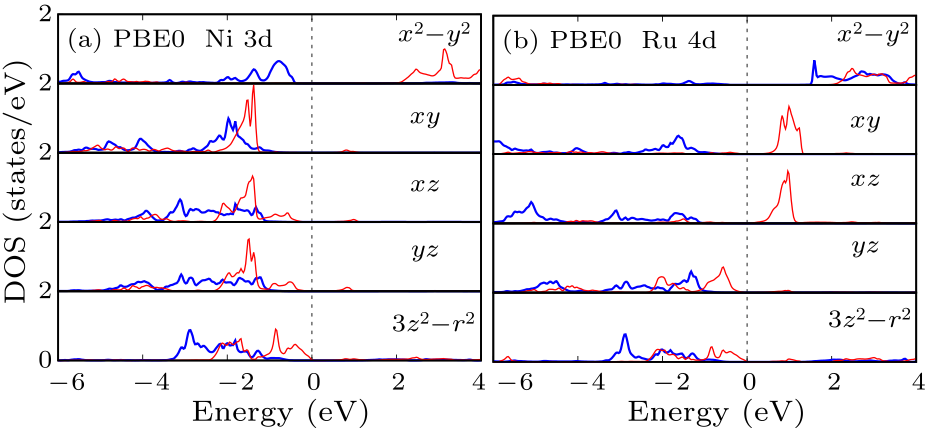
Fig. 1. Crystal structure of (a) layered LaSr$_{3}$NiRuO$_{4}$H$_{4}$ with the assumed Ni–Ru order (the local NiH$_4$O$_2$ and RuH$_4$O$_2$ octahedra), and of (b) LaSrNiRuO$_{4}$ with the local NiO$_4$ and RuO$_4$ planar squares. Schematic crystal field level diagrams of (c) Ni$^+$ $S=1/2$ and Ru$^{2+}$ $S=0$ in LaSr$_{3}$NiRuO$_{4}$H$_{4}$, and of (d) Ni$^+$ $S=1/2$ and Ru$^{2+}$ $S=1$ in LaSrNiRuO$_{4}$. (c) A weak antiferromagnetic (AF) superexchange would occur in the Ni$^+$ $S=1/2$ sublattice of LaSr$_{3}$NiRuO$_{4}$H$_{4}$, and (d) the multi-orbital strong FM superexchange between Ni$^+$ $S=1/2$ and Ru$^{2+}$ $S=1$ would appear in LaSrNiRuO$_{4}$.
| $\Delta E$ | tot | Ni | Ru | |||
|---|---|---|---|---|---|---|
| LSDA | FM | 0.88 | 0.64 | 0.02 | ||
| LaSr$_{3}$NiRuO$_{4}$H$_{4}$ | LSDA+$U$ | FM | 0 | 1.00 | 0.89 | 0.02 |
| AF | $-$0.27 | 0.00 | 0.89 | 0.00 | ||
| LaSrNiRuO$_{4}$ | LSDA+$U$ | FM | 0 | 3.00 | 1.03 | 1.63 |
| Ref. | AF | 126 | 0.00 | 0.87 | 1.48 | |
| PBE0 | FM | 0 | 3.00 | 0.97 | 1.52 | |
| AF | 135 | 0.00 | 0.88 | 1.39 | ||
| LaSrNiZnO$_4$ | LSDA+$U$ | FM | 0 | 0.92 | 0.98 | |
| AF | $-$2.36 | 0.00 | 1.05 |

Fig. 2. Ni $3d$ and Ru $4d$ DOS of LaSr$_{3}$NiRuO$_{4}$H$_{4}$ calculated by LSDA. The blue (red) curves stand for the majority (minority) spin channel. The Fermi level is set at zero energy.

Fig. 3. Ni $3d$ and Ru $4d$ DOS of LaSr$_{3}$NiRuO$_{4}$H$_{4}$ calculated by LSDA+$U$. The blue (red) curves stand for the majority (minority) spin channel. The Fermi level is set at zero energy.

Fig. 4. Ni $3d$ and Ru $4d$ DOS of LaSrNiRuO$_{4}$ calculated by PBE0. The blue (red) curves stand for the majority (minority) spin channel. The Fermi level is set at zero energy.
| [1] | Tokura Y and Nagaosa N 2000 Science 288 462 | Orbital Physics in Transition-Metal Oxides
| [2] | Dagotto E 2005 Science 309 257 | Complexity in Strongly Correlated Electronic Systems
| [3] | Hwang H Y, Iwasa Y, Kawasaki M, Keimer B, Nagaosa N and Tokura Y 2012 Nat. Mater. 11 103 | Emergent phenomena at oxide interfaces
| [4] | Ou X, Wang H, Fan F, Li Z and Wu H 2015 Phys. Rev. Lett. 115 257201 | Giant Magnetic Anisotropy of Co, Ru, and Os Adatoms on MgO (001) Surface
| [5] | Fan F, Li Z, Zhao Z, Yang K and Wu H 2016 Phys. Rev. B 94 214401 | Unusual high-spin state and strong ferromagnetism in the mixed perovskite
| [6] | Yajima T, Kitada A, Kobayashi Y, Sakaguchi T, Bouilly G, Kasahara S, Terashima T, Takano M and Kageyama H 2012 J. Am. Chem. Soc. 134 8782 | Epitaxial Thin Films of ATiO 3– x H x (A = Ba, Sr, Ca) with Metallic Conductivity
| [7] | Hayward M A, Cussen E J, Claridge J B, Bieringer M, Rosseinsky M J, Kiely C J, Blundell S J, Marshall I M and Pratt F L 2002 Science 295 1882 | The Hydride Anion in an Extended Transition Metal Oxide Array: LaSrCoO3H0.7
| [8] | Denis R F, Leach A, Möller J S, Foronda F, Blundell S J and Hayward M A 2014 Angew. Chem. Int. Ed. 53 7556 | Strontium Vanadium Oxide-Hydrides: “Square-Planar” Two-Electron Phases
| [9] | Tassel C, Goto Y, Kuno Y, Hester J, Green M, Kobayashi Y and Kageyama H 2014 Angew. Chem. Int. Ed. 53 10377 | Direct Synthesis of Chromium Perovskite Oxyhydride with a High Magnetic-Transition Temperature
| [10] | Jin L, Lane M, Zeng D, Kirschner F K, Lang F, Manuel P, Blundell S J, McGrady J E and Hayward M A 2018 Angew. Chem. Int. Ed. 57 5025 | LaSr 3 NiRuO 4 H 4 : A 4d Transition-Metal Oxide-Hydride Containing Metal Hydride Sheets
| [11] | Patino M A, Zeng D, Bower R, McGrady J E and Hayward M A 2016 Inorg. Chem. 55 9012 | Coupled Electronic and Magnetic Phase Transition in the Infinite-Layer Phase LaSrNiRuO 4
| [12] | Zhu S, Fan F, Yang K and Wu H 2017 Europhys. Lett. 117 37005 | Ferromagnetism in the unusual low-valence layered material LaSrNiRuO 4
| [13] | Blaha P, Schwarz K, Madsen G K H, Kvasnicka D and Luitz J 2001 Wien2k package (http://www.wien2k.at) |
| [14] | Anisimov V I, Solovyev I V, Korotin M A, Czyżyk M T and Sawatzky G A 1993 Phys. Rev. B 48 16929 | Density-functional theory and NiO photoemission spectra
| [15] | Ernzerhof M and Scuseria G E 1999 J. Chem. Phys. 110 5029 | Assessment of the Perdew–Burke–Ernzerhof exchange-correlation functional
| [16] | Perdew J P, Ernzerhof M and Burke K 1996 J. Chem. Phys. 105 9982 | Rationale for mixing exact exchange with density functional approximations
| [17] | Tran F, Blaha P, Schwarz K and Novák P 2006 Phys. Rev. B 74 155108 | Hybrid exchange-correlation energy functionals for strongly correlated electrons: Applications to transition-metal monoxides
| [18] | Wu H, Hu Z, Burnus T, Denlinger J D, Khalifah P G, Mandrus D G, Jang L Y , Hsieh H H, Tanaka A, Liang K S, Allen J W, Cava R J, Khomskii D I and Tjeng L H 2006 Phys. Rev. Lett. 96 256402 | Orbitally Driven Spin-Singlet Dimerization in
| [19] | Shannon R D 1976 Acta Crystallogr. Sect. A: Cryst. Phys. Diffr. Theor. Gen. Crystallogr. 32 751 | Revised effective ionic radii and systematic studies of interatomic distances in halides and chalcogenides